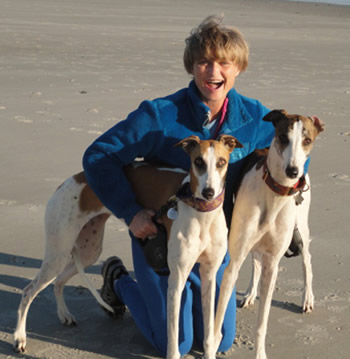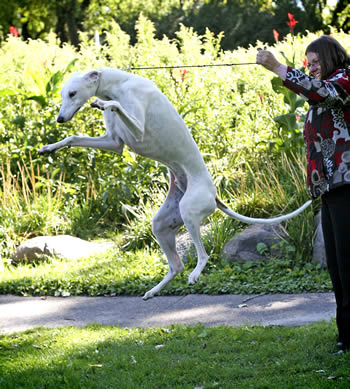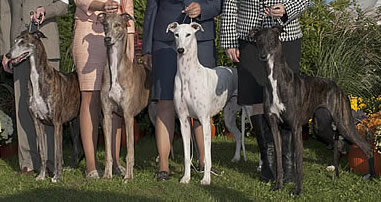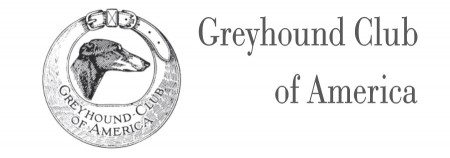About the Greyhound
Purpose
The Greyhound is a sighthound and one of the oldest breeds of dogs. Sighthounds are hunting dogs that pursue running game by sight rather than by scent. This manner of hunting is called “coursing”. The attributes of speed, agility, strength and endurance are necessary to catch and hold game. The feature that distinguishes Greyhounds (and sighthounds) is their ability to run at speeds of 35 miles per hour or more using the double suspension gallop. The Greyhound demonstrates the double suspension gallop in its highest perfection. Their incredible speed comes from the singular combination of skeletal structure, musculature, and the ability to focus completely on the object of the chase.
Greyhounds and other sighthounds course game independently of humans. Sighthounds are unlike other breeds such as herding dogs that take signals from humans when moving sheep from pasture to pen or sporting dog breeds that range out to point and hold birds in one spot until their human indicates it’s time to flush. Once the chase is on and the Greyhound is on its way, there is very little you can do to intervene until the chase is over.
Appearance
Greyhounds are tall, sleek, curvaceous, powerful, smooth, well-muscled; they stand over a lot of ground, and have a long, whip-like tail. Their legs are long and their feet have arched well-knuckled toes. Their skin and hair coat is soft and fine. Their heads and muzzles are long and narrow. The ears are tightly folded back during the chase or when resting and raised outward into a folded gull-wing when alert. Notably, the Greyhound is stamped with elegant nobility.
Generally, Greyhound females weigh from 50 to 70 pounds, and males will weigh from 65 to 85 pounds. Greyhounds come in many colors and shades, parti (white with patches another color) and solid, as you can see throughout this website. Color was not considered important during ancient times because their ability to successfully course game was far more necessary.


Temperament
Even as the Greyhound has a specialized appearance, so is its temperament. Though they were bred to chase and grab all manner of game, which demands strength and fearlessness, Greyhounds have even temperaments with people. Because of their unique ability and useful purpose, they have resided inside castles and fortresses with nobility and been well cared for. This close association with their owners and care-givers for thousands of years has been selective for even-tempered, quiet dogs that are gentle around people. As you will notice, Greyhounds have very little fat or coat to cushion them from the bumps, trips, and grabs of small children. They are sensitive to this type of pain and annoyance and may react quickly, so very be alert when Greyhounds and toddlers are near each other.
Life with Greyhounds
How much space does a Greyhound need? Inside the home a Greyhound will take up as much space as you let him. They are long dogs after all. If allowed on the people furniture, they will stretch out to the maximum. Greyhounds use their height and long necks to cruise counter tops for tasty morsels, their long tails accidentally knock trinkets off coffee tables quite easily. One must ready one’s home prior to the arrival of your first Greyhound. Your dog will need a large or giant wire crate equipped with a water bucket and soft pads (Not Memory-Foam!) for those times they will be home alone.
Greyhounds are social and do like to have company, especially the company of another Greyhound so they can amuse themselves by running around the fenced backyard. Yes, FENCED backyard. Because they run so very fast, Greyhounds will get very far away in a very short time. Unfortunately, they don’t seem to hear very well once they run off after something interesting. Calling out “Stop Speedy” or “Speedy, Come Back” will go unheeded UNLESS you have taken your Greyhound through obedience classes and you have practiced this command successfully in a FENCED area first. Greyhounds are independent because it does no good for a coursing dog to stop and turn back to you once the chase has begun. Coursing game, the purpose they have been bred for all these years, requires a temperament that is independent of interaction with humans to be successful.
Most Greyhounds won’t follow you around the house and try to get in your lap or fawn all over you. They will lie down on a soft bed and watch you do chores until you look like you are going to open the door, or start to fix supper. If you pick up a leash, or even as you get close to the place where the leash hangs, they will instantly jump up and run over, assuming you are finally ready to go chase something (or take them on a walk).
Greyhounds are not good guard dogs because they just haven’t been bred to challenge people or be aggressive. That said, they can be quite barky and territorial if they see another dog or stranger on the street outside of their FENCED yard.

Exercise
Greyhounds do spend lot of time sleeping or lounging around. They are more like cheetahs than active breeds that are in constant motion all day, such as terriers or collies. Greyhounds conserve energy for the chase; expend almost all they can, then rest up until time for another chase. It’s what they do.
Greyhounds should be kept on a regular schedule of outside breaks and exercise time. They do need an outlet for all that stored-up energy. Regular exercise times when they can run around in a large fenced area every day are a necessity.
Food
Your Greyhound’s breeder will be the best guide for kinds and amount of dog food your hound will need. Of course, a growing puppy has different nutritional needs from a mature or senior Greyhound. However, you should plan on buying a lot of high-quality dog food throughout the Greyhound’s life. They do need a lot of calories and a lot of protein because of their manner of running at extreme speed. Once they become older, you will need to modify the diet, yet allow them all the exercise they want. It is important to be consistent in the foods you give. Do not jump around from one brand to another; take time modifying the diet because quick changes will result in unpleasant and/or untimely elimination of offending matter, and will not result in the desired improvements.
Health
Parasites – Greyhounds get worms and other internal parasites, same as other breeds. Greyhounds must be treated for internal parasites regularly, and the schedule will depend on what part of the country you live in. Consult with your veterinarian, provide a fecal sample from your dog, and use the medication they prescribe for treatment. Put the recommended deworming schedule into your planner or onto your calendar and stick to it.

Want to know more?
Contact one of the people listed on the “GCA Approved Seminar Presenters” page or attend an upcoming “Meet the Breed” events that occur throughout the year at some dog shows. Contact your local all-breed club and ask if they will be host one of these events including Greyhounds.
For more information check
Be sure to also look at the educational pages on our website
